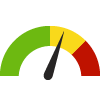Indicator Gauge Icon Legend
Legend Colors
Red is bad, green is good, blue is not statistically different/neutral.
Compared to Distribution
 the value is in the best half of communities.
the value is in the best half of communities.
 the value is in the 2nd worst quarter of communities.
the value is in the 2nd worst quarter of communities.
 the value is in the worst quarter of communities.
the value is in the worst quarter of communities.
Compared to Target
 meets target;
meets target;  does not meet target.
does not meet target.
Compared to a Single Value
 lower than the comparison value;
lower than the comparison value;
 higher than the comparison value;
higher than the comparison value;
 not statistically different from comparison value.
not statistically different from comparison value.
Trend

 non-significant change over time;
non-significant change over time; 
 significant change over time;
significant change over time;  no change over time.
no change over time.
Compared to Prior Value
 higher than the previous measurement period;
higher than the previous measurement period;
 lower than the previous measurement period;
lower than the previous measurement period;
 no statistically different change from previous measurement period.
no statistically different change from previous measurement period.
 Significantly different than the overall value
Significantly different than the overall value
 No significant difference with the overall value
No significant difference with the overall value
 No data on significance available
No data on significance available
Heroin Treatment Rate
This indicator is archived and is no longer being updated. Click to learn more
Why is this important?
Drug abuse and addiction comprise a public health problem that affects many people and has wide-ranging social consequences. These consequences can include poor health outcomes, increased crime and accidents, and increased unemployment and homelessness. Heroin is a very addictive stimulant drug that affects the central nervous system and has a high potential for abuse. Heroin abuse significantly changes how the brain functions. Overdoses often result in hypoxia, where there is a lack of oxygen reaching the brain. Chronic heroin use results in many damaging effects including physical dependence, tolerance, and deterioration of the brain's white matter. Furthermore, heroin use during pregnancy can result in poor birth outcomes or spontaneous abortions.
Due to the nature of drug addiction, effective treatment programs typically incorporate many components, each directed to a particular aspect of the illness and its consequences. Addiction treatment must help the individual stop using drugs, maintain a drug-free lifestyle, and achieve productive functioning in the family, at work, and in society. Because addiction is typically a chronic disease, people cannot simply stop using drugs for a few days and be cured. Most patients require long-term or repeated episodes of care to achieve the ultimate goal of sustained abstinence and recovery of their lives.
| County | Source | Measurement Period | Admissions per 1,000 population | |
|---|---|---|---|---|
Data Source
- Indiana University Center for Health Policy
Maintained By: Conduent Healthy Communities Institute (Methodology)
Filed under: Health / Alcohol & Drug Use, Clinical Care

